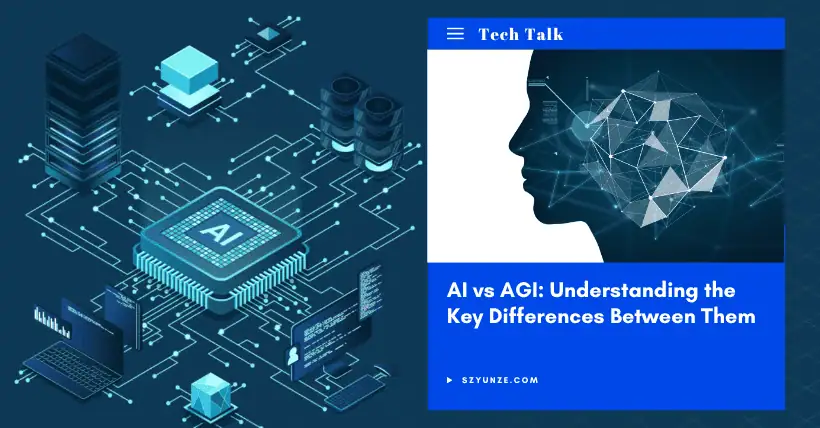I. Introduction
Currently, there are two popular high-frequency terms in the field of AI: AI and AGI. Their meanings in Chinese are Artificial Intelligence and Artificial General Intelligence, respectively. Many people may not understand the difference between the two, and they are often confused. This article will briefly introduce them.
II. Definition of AI
The full English name of AI is “Artificial Intelligence,” abbreviated as “AI.” It is a field that aims to develop theories, methods, technologies, and application systems that can simulate, extend, and expand human intelligence. It covers many areas, from computer science and statistics to neuroscience and psychology. Through various technical means, AI enables machines to perform tasks that originally required human intelligence.
In recent years, deep learning, a popular branch of machine learning, has made breakthrough progress in areas such as image recognition, speech recognition, and natural language processing, thanks to its powerful neural network architecture. For example, in image recognition, convolutional neural networks (CNN) can automatically extract features from images and accurately classify various objects and scenes, with accuracy levels even surpassing human performance.
III. Definition of AGI
The full English name of Artificial General Intelligence is “Artificial General Intelligence,” abbreviated as “AGI.” Unlike AI, which focuses on specific tasks, AGI aims to create systems with human-like general intelligence capabilities. It can not only understand complex concepts and engage in abstract thinking but also flexibly apply knowledge and skills to various fields and contexts, much like humans, handling the ever-changing real world.
IV. Differences between AI and AGI
✅ Different Scope of Abilities
AI applications are highly vertical and narrow, usually only effective within specific fields or tasks. AI focuses on a single task and lacks the ability to learn and adapt across domains. They often perform well in their designated applications but cannot go beyond their preset functions.
On the other hand, AGI has broad generality. It can learn, reason, and make decisions like humans. AGI can not only complete specific tasks but also flexibly handle new tasks and environments, demonstrating a broader adaptability and self-updating ability.
✅ Difference in Autonomy and Adaptability
Although AI systems can handle complex tasks, they usually operate based on large amounts of data and predefined algorithms, lacking true autonomy. Learning typically relies on vast amounts of training data and requires manual setting of goals and feedback.
AGI, however, has the ability to autonomously learn like humans. It can not only complete known tasks but also independently identify and solve new problems. It possesses higher adaptability and flexibility, making decisions autonomously based on the changing environment.
✅ Different Technical Paths
AI primarily relies on machine learning, supervised learning, reinforcement learning, and other techniques to train models using big data to perform tasks. These models may excel in specific tasks, but they generally cannot transfer experience to other tasks or domains.
AGI requires the development of more advanced capabilities, such as meta-learning and causal reasoning, to achieve cross-domain learning and transfer. These abilities will allow AGI systems to generalize rules from small amounts of data and apply them to different scenarios and tasks, making its overall implementation much more difficult.
✅ Different Stages of Development
At present, AI technology has been largely realized and is continuously developing, with widespread applications across various fields. It is becoming an important driving force for social progress and economic development.
AGI, however, is still in the theoretical exploration stage. Although some large models and AI agents have excelled in specific tasks, they are far from reaching true AGI levels. Currently, no system has passed the Turing test or achieved human-level cognitive evaluation.
V. Conclusion
In summary, AI at this stage mainly focuses on solving specific, localized tasks, representing the early stage of Artificial Intelligence. AGI, on the other hand, aims for comprehensive, integrated, and cross-domain human-like intelligence, representing the advanced stage of Artificial Intelligence, which is still in the early theoretical exploration phase.
Related:

Disclaimer:
- This channel does not make any representations or warranties regarding the availability, accuracy, timeliness, effectiveness, or completeness of any information posted. It hereby disclaims any liability or consequences arising from the use of the information.
- This channel is non-commercial and non-profit. The re-posted content does not signify endorsement of its views or responsibility for its authenticity. It does not intend to constitute any other guidance. This channel is not liable for any inaccuracies or errors in the re-posted or published information, directly or indirectly.
- Some data, materials, text, images, etc., used in this channel are sourced from the internet, and all reposts are duly credited to their sources. If you discover any work that infringes on your intellectual property rights or personal legal interests, please contact us, and we will promptly modify or remove it.



